Author : Robert A. Copeland
Language : ENGLISH

|
Call no. QP601.5 C782E 2012
Book Description Using detailed examples, Evaluation of Enzyme Inhibitors in Drug Discovery equips researchers with the tools needed to apply the science of enzymology and biochemistry to the discovery, optimization, and preclinical development of drugs that work by inhibiting specific enzyme targets. Readers will applaud this book for its clear and practical presentations, including its expert advice on best practices to follow and pitfalls to avoid.This Second Edition brings the book thoroughly up to date with the latest research findings and practices. Updates explore additional forms of enzyme inhibition and special treatments for enzymes that act on macromolecular substrates. Readers will also find new discussions detailing the development and application of the concept of drug-target residence time.Evaluation of Enzyme Inhibitors in Drug Discovery begins by explaining why enzymes are such important drug targets and then examines enzyme reaction mechanisms. The book covers: Reversible modes of inhibitor interactions with enzymes
Assay considerations for compound library screening
Lead optimization and structure-activity relationships for reversible inhibitors
Slow binding and tight binding inhibitors
Drug-target residence time
Irreversible enzyme inactivators
The book ends with a new chapter exploring the application of quantitative biochemical principles to the pharmacologic evaluation of drug candidates during lead optimization and preclinical development.The Second Edition of Evaluation of Enzyme Inhibitors in Drug Discovery continues to offer a treatment of enzymology applied to drug discovery that is quantitative and mathematically rigorous. At the same time, the clear and simple presentations demystify the complex science of enzymology, making the book accessible to many fields— from pharmacology to medicinal chemistry to biophysics to clinical medicine. (amazon.com) |
Editor : Arthur C. Petersen
Language : ENGLISH
Editor : Arthur C. Petersen
Language : ENGLISH
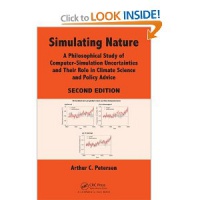 |
Call no. QC981.45 P481S 2012
Book Description Computer simulation has become an important means for obtaining knowledge about nature. The practice of scientific simulation and the frequent use of uncertain simulation results in public policy raise a wide range of philosophical questions. Most prominently highlighted is the field of anthropogenic climate change—are humans currently changing the climate? Referring to empirical results from science studies and political science, Simulating Nature: A Philosophical Study of Computer-Simulation Uncertainties and Their Role in Climate Science and Policy Advice, Second Edition addresses questions about the types of uncertainty associated with scientific simulation and about how these uncertainties can be communicated. The author, who participated in the United Nations’ Intergovernmental Panel on Climate Change (IPCC) plenaries in 2001 and 2007, discusses the assessment reports and workings of the IPCC. This second edition reflects the latest developments in climate change policy, including a thorough update and rewriting of sections that refer to the IPCC. (amazon.com) |
Author : Graham L. Patrick
Language : ENGLISH
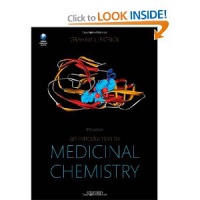 |
Call no. RS403 P314I 2013
Book Description An Introduction to Medicinal Chemistry is the leading text for university courses on this subject. Renowned for being a textbook loved equally by both students and lecturers, it presents complete coverage in an accessible and engaging style. The text begins with the essential biochemistry on which an understanding of medicinal chemistry is built, introducing the structure and function of important drug targets. It then explores how drugs interact with the body and the consequences of those reactions. There is a section on general principles and strategies involved in discovering and designing new drugs, and another on useful ‘tools of the trade’. The text ends with a contemporary look at specific topics within medicinal chemistry, for example, antiviral and anticancer agents; cholinergics and anticholinesterases; and antiulcer agents. Learning features throughout An Introduction to Medicinal Chemistry help to unlock this fascinating subject. A glossary helps to familiarise the language of medicinal chemistry. Boxes present in-depth material and explore how concepts are applied in practice. Key points summarise sections within chapters, providing a basis for revision, and questions at the end of chapters and on the accompanying Online Resource Centre allow the reader to test their understanding and develop molecular modelling skills. (amazon.com) |
Editor : Gade Pandu Rangaiah , Vinay Kariwala
Language : ENGLISH
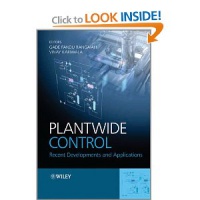 |
Call no. TP155.75 P713 2012
Book Description The use of control systems is necessary for safe and optimal operation of industrial processes in the presence of inevitable disturbances and uncertainties. Plant-wide control (PWC) involves the systems and strategies required to control an entire chemical plant consisting of many interacting unit operations. Over the past 30 years, many tools and methodologies have been developed to accommodate increasingly larger and more complex plants. This book provides a state-of-the-art of techniques for the design and evaluation of PWC systems. Various applications taken from chemical, petrochemical, biofuels and mineral processing industries are used to illustrate the use of these approaches. This book contains 20 chapters organized in the following sections: Overview and Industrial Perspective
Tools and Heuristics
Methodologies
Applications
Emerging Topics
With contributions from the leading researchers and industrial practitioners on PWC design, this book is key reading for researchers, postgraduate students, and process control engineers interested in PWC. (amazon.com) |
Editor : Helena Bender
Language : ENGLISH
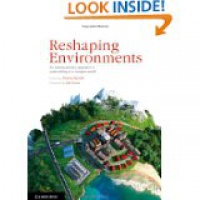 |
Call no. HD30.255 R433 2012
Book Description Reshaping Environments: An Interdisciplinary Approach to Sustainability in a Complex World draws together a team of specialist authors from disciplines including urban planning, social sciences, engineering and environmental science to examine the diverse influences humans have upon the natural environment. This interdisciplinary approach presents multifaceted responses for complex environmental issues. The book explores current environmental science theories to provide a solid foundation of theoretical knowledge. Drawing on a range of case studies, it develops core analytical skills for application to real-world environmental issues. Reshaping Environments gives environmental science students the tools and insight to comprehend the range of influences society imposes on the natural environment. It is essential reading for those interested in creating a mutually beneficial future for human society and the natural environment. (amazon.com) |
Editor : Nguyen Thi Kim Oanh
Language : ENGLISH
 |
Call no. TD883.7.A78 I61 2013
Book Description The steady growth in the number of vehicles on the road, heavy reliance on coal, use of dirty fuels for residential combustion, and extensive open burning are some of the major factors leading to the progressive deterioration of air quality in developing countries in Asia. And despite efforts to establish and implement air quality measurement systems, the development of infrastructure, environmental technology, and management practices continues to lag behind the rate of emission increase. Based on ten years of coordinated research, Integrated Air Quality Management: Asian Case Studies discusses technical and policy tools for the integrated air quality management of developing countries in Asia. The book begins with an overview of major issues of air quality management practices in developing Asia and potential approaches to reduce pollution, including opportunities for integration of air quality improvement and climate migration strategies. It covers the methodology and results of fine particulate matter monitoring using traditional filter-based and satellite monitoring techniques. It examines the applications of a 3D dispersion modeling tool for urban and regional air quality management focusing on surface ozone, fine particulate matter, and acid deposition. The final chapters discuss innovative control technologies for gaseous air pollutants and illustrate the integrated air quality management in developing Asia through case studies for target source categories including agricultural residue field burning, vehicle emissions, brick kilns, and industrial VOC emission. Illustrated with case studies, this book presents an integrated air quality management methodology that employs technical and policy tools to achieve air quality goals. It includes technical information and policy recommendations based on the outcomes of several multi-year air quality research programs coordinated by the Asian Institute of Technology. The text combines fundamental information and advanced knowledge useful to large audiences dealing with subjects of integrated air quality management. (amazon.com) |
Author : Stephen M. Wheeler
Language : ENGLISH
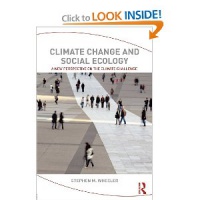 |
Call no. QC903 W564C 2012
Book Description Although strategies to prevent global warming – such as by conserving energy, relying on solar and wind power, and reducing motor vehicle use – are well-known, societies have proved unable to implement these measures with the necessary speed. They have also been unwilling to confront underlying issues such as overconsumption, overpopulation, inequity, and dysfunctional political systems. Political and social obstacles have prevented the adoption of improved technologies, which would provide only a partial solution in any case if the fundamental causes of greenhouse gas emissions aren’t addressed. Climate Change and Social Ecology takes a new approach to the climate crisis, portraying global warming as a challenge of rapid social evolution. This book argues that, in order to address this impending catastrophe and bring about more sustainable development, we must focus on improving social ecology – our values, mind-sets, and social organization. Steps to do this include institutional reforms to improve democracy, educational strategies to encourage public understanding of complex issues, and measures to prevent corporations and the wealthy from shaping societies in other directions instead. This book presents a captivating vision of how to help social systems evolve toward sustainability and explores the social transformations needed for dealing with the climate crisis in the long term. It reviews the climate change strategies considered to date, presents a detailed description of a future sustainable society, and analyzes how this vision might be realized through more conscious public nurturing of our social systems. This interdisciplinary volume provides a compelling rethink of the climate crisis. Authoritative and accessible, it will be of great interest to anyone concerned about climate change and sustainability challenges and is essential reading for students, professionals, and general readers alike. (amazon.com) |
Author : Michael R. Greenberg
Language : ENGLISH
 |
Call no. KF3775 G795E 2012
Book Description This book is about a subject that Michael Greenberg has worked on and lived with for almost forty years. He was brought up in the south Bronx at a time when his neighborhood suffered from terrible air and noise pollution, and domestic waste went untreated into the Hudson River. For him, the National Environmental Policy Act (NEPA) was a blessing. It included an ethical position about the environment, and the law required some level of accountability in the form of an environmental impact statement, or EIS. After forty years of thinking about and working with NEPA and the EIS process, Greenberg decided to conduct his own evaluation from the perspective of a person trained in science who focuses on environmental and environmental health policies. This book of carefully chosen real case studies goes beyond the familiar checklists of what to do, and shows students and practitioners alike what really happens during the creation and implementation of an EIS. (amazon.com) |
Author : Richard C. Peralta
Language : ENGLISH
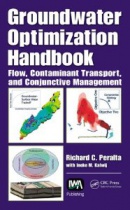 |
Call no. TD426 P426G 2012
Book Description Existing and impending water shortages argue for improving water quantity and quality management. Groundwater Optimization Handbook: Flow, Contaminant Transport, and Conjunctive Management helps you formulate and solve groundwater optimization problems to ensure sustainable supplies of adequate quality and quantity. It shows you how to more effectively use simulation-optimization (S-O) modeling, an economically valuable groundwater management tool that couples simulation models with mathematical optimization techniques. Written for readers of varying familiarity with groundwater hydrology and mathematical optimization, the handbook approaches complex problems realistically. Its techniques have been applied in many legal settings, with produced strategies providing up to 57% improvement over those developed without S-O modeling. These techniques supply constructible designs, planning and management strategies, and metrics for performance-based contracts. Learn how to: Recognize opportunities for applying S-O models
Lead client, agency, and consultant personnel through the strategy design and adaptation process
Formulate common situations as clear deterministic/stochastic and single/multiobjective mathematical optimization problems
Distinguish between problem nonlinearities resulting from physical system characteristics versus management goals
Create an S-O model appropriate for your specific needs or select an existing transferrable model
Develop acceptable feasible solutions and compute optimal solutions
Quantify tradeoffs between multiple objectives
Evaluate and adapt a selected optimal strategy, or use it as a metric for comparison
Drawing on the author’s numerous real-world designs and more than 30 years of research, consulting, and teaching experience, this practical handbook supplies design procedures, detailed flowcharts, solved problems, lessons learned, and diverse applications. It guides you through the maze of multiple objectives, constraints, and uncertainty to calculate the best strategies for managing flow, contamination, and conjunctive use of groundwater and surface water. (amazon.com) |
Editor : Pedro Merino
Language : ENGLISH
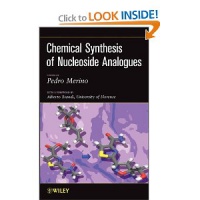 |
Call no. RM411 C517 2013
Book Description Featuring contributions from leading synthetic chemists from around the world, this book brings together and describes tested and proven approaches for the chemical synthesis of common families of nucleoside analogues. Readers will learn to create new nucleoside analogues with desired therapeutic properties by using a variety of methods to chemically modify natural nucleosides, including: Changes to the heterocyclic base
Modification of substituents at the sugar ring
Replacement of the furanose ring by a different carbo- or heterocyclic ring
Introduction of conformational restrictions
Synthesis of enantiomers
Preparation of hydrolitically stable C-nucleosides
Chemical Synthesis of Nucleoside Analogues covers all the major classes of nucleosides, including pronucleotides, C-nucleosides, carbanucleosides, and PNA monomers which have shown great promise as starting points for the synthesis of nucleoside analogues. The book also includes experimental procedures for key reactions related to the synthesis of nucleoside analogues, providing a valuable tool for the preparation of a number of different compounds. Throughout the book, chemical schemes and figures help readers better understand the chemical structures of nucleoside analogues and the methods used to synthesize them. Extensive references serve as a gateway to the growing body of original research studies and reviews in the field. Synthetically modified nucleosides have proven their value as therapeutic drugs, in particular as antiviral and antitumor agents. However, many of these nucleoside analogues have undesirable side effects. With Chemical Synthesis of Nucleoside Analogues as their guide, researchers have a new tool for synthesizing a new generation of nucleoside analogues that can be used as therapeutic drugs with fewer unwanted side effects. (amazon.com) |
Editor : Glenn R. Iason, Marcel Dicke, Susan E. Hartley
Language : ENGLISH
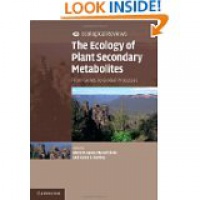 |
Call no. QK887 E24 2012
Book Description Plant secondary metabolites (PSM) such as terpenes and phenolic compounds are known to have numerous ecological roles, notably in defence against herbivores, pathogens and abiotic stresses and in interactions with competitors and mutualists. This book reviews recent developments in the field to provide a synthesis of the function, ecology and evolution of PSM, revealing our increased awareness of their integrative role in connecting natural systems. It emphasises the multiple roles of secondary metabolites in mediating the interactions between organisms and their environment at a range of scales of ecological organisation, demonstrating how genes encoding for PSM biosynthetic enzymes can have effects from the cellular scale within individual plants all the way to global environmental processes. A range of recent methodological advances, including molecular, transgenic and metabolomic techniques, are illustrated and promising directions for future studies are identified, making this a valuable reference for researchers and graduate students in the field. (amazon.com) |
Author : Nilashis Nandi
Language : ENGLISH
 |
Call no. QP517.C57 N176 2012
Book Description Chirality is widely studied and omnipresent in biological molecules. However, how the retention of enantiomeric forms persists in many life processes without racemization is still unclear, and the molecular understanding of the stringent chiral specificity in enzymatic reactions is sparse. An overview of the influence of chirality in driving reactions within enzymatic cavities, Chirality in Biological Nanospaces: Reactions in Active Sites covers: Influences of molecular chirality on the structure of the active site and network of interactions to drive reactions with improved speed, accuracy, and efficiency
The conserved features of the organization of the active site structures of enzymes
The intricate interplay of electrostatic, hydrophobic, and van der Waals interactions
Interactions between the active site residues and the substrate molecules
Despite being time-consuming and expensive, trial-and-error is often the primary method used to develop synthetic enzymes. This book describes methods that combine crystallographic studies with electronic structure-based computational analysis. These methods may lead to future elucidation of new drugs that can target biological active sites with better efficacy and can be used to design custom-made novel biocytes with improved efficiency. (amazon.com) |
Author : Zbigniew J. Witczak, Roman Bielski
Language : ENGLISH
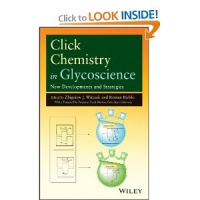 |
Call no. QP552.G59 C636 2013
Book Description Introduced by K. Barry Sharpless of The Scripps Research Institute in 2001, click chemistry mimics nature, giving researchers the tools needed to generate new substances quickly and reliably by joining small units together. With contributions from more than thirty pioneering researchers in the field, this text explores the many promising applications of click chemistry in glycoscience. Readers will learn both the basic concepts of carbohydrate click chemistry as well as its many biomedical applications, including synthetic antigens, analogs of cell-surface receptors, immobilized enzymes, targeted drug delivery systems, and multivalent cancer vaccines. Click Chemistry in Glycoscience examines a broad range of methodologies and strategies that have emerged from this rapidly evolving field. Each chapter describes new approaches, ideas, consequences, and applications resulting from the introduction of click processes. Divided into four sections, the book covers: Click chemistry strategies and decoupling
Thio-click chemistry of carbohydrates
Carbohydrate click chemistry for novel synthetic targets
Carbohydrate click chemistry in biomedical sciences
Thoroughly researched, the book reflects the most recent findings published in the literature. Diagrams and figures throughout the book enable readers to more easily grasp complex concepts and reaction processes. At the end of each chapter, references lead to the primary literature for further investigation of individual topics. The application of click chemistry to carbohydrates has tremendous implications for research. With this book as their guide, researchers have a solid foundation from which they can develop new methods and applications of carbohydrate click chemistry, including new carbohydrate-based therapeutics. (amazon.com) |
Author : Jung Soh, Paul M.K. Gordon, Christoph W. Sensen
Language : ENGLISH
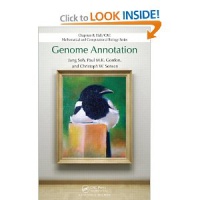 |
Call no. QH447 S682G 2013
Book Description The success of individualized medicine, advanced crops, and new and sustainable energy sources requires thoroughly annotated genomic information and the integration of this information into a coherent model. A thorough overview of this field, Genome Annotation explores automated genome analysis and annotation from its origins to the challenges of next-generation sequencing data analysis. The book initially takes you through the last 16 years since the sequencing of the first complete microbial genome. It explains how current analysis strategies were developed, including sequencing strategies, statistical models, and early annotation systems. The authors then present visualization techniques for displaying integrated results as well as state-of-the-art annotation tools, including MAGPIE, Ensembl, Bluejay, and Galaxy. They also discuss the pipelines for the analysis and annotation of complex, next-generation DNA sequencing data. Each chapter includes references and pointers to relevant tools. As very few existing genome annotation pipelines are capable of dealing with the staggering amount of DNA sequence information, new strategies must be developed to accommodate the needs of today’s genome researchers. Covering this topic in detail, Genome Annotation provides you with the foundation and tools to tackle this challenging and evolving area. Suitable for both students new to the field and professionals who deal with genomic information in their work, the book offers two genome annotation systems on an accompanying CD-ROM. (amazon.com) CD-ROM included: GC197
|
Author, Editor: Dominic C Y Foo, Mahmoud M El-Halwagi, Raymond R Tan
Language : ENGLISH
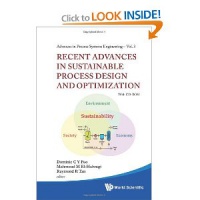 |
Call no. TP155.7 R296 2012
Book Description This book is a compilation of the various recently developed techniques emphasizing better chemical processes and products, with state-of-the-art contributions by world-renowned leaders in process design and optimization. It covers various areas such as grass-roots design, retrofitting, continuous and batch processing, energy efficiency, separations, and pollution prevention, striking a balance between fundamental techniques and applications. The book also contains industrial applications and will serve as a good compilation of recent industrial experience for which the process design and optimization techniques were applied to enhance sustainability. Academic researchers and industrial practitioners will find this book useful as a review of systematic approaches and best practices in sustainable design and optimization of industrial processes. The book is accompanied by some electronic supplements (i.e., models and programs) for selected chapters. (amazon.com) CD-ROM included: GC196
|
